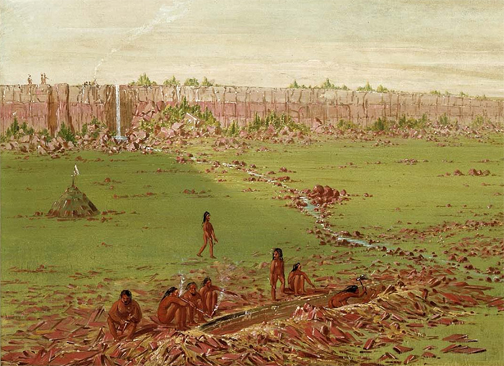
“Pipestone Quarry on the Coteau des Prairies” George Catlin Oil on canvas. Smithsonian American Art Museum. 1985.66.337
August 25, 1937
“Congress establishes the state’s first national monument–Pipestone National Monument–in southwestern Minnesota.” *
Monuments typically are structures or markers that are placed to guide society to remember that something of significance. In this case, the item of importance is literally a type of stone specimens of a quality rarely found in elsewhere. Below is a brief excerpt, that gives us a little scientific footing to understand it.
“The Early Proterozoic Sioux Quartzite of southwestern Minnesota accumulated as sedimentary sand layers deposited by streams that flowed across an erosional surface developed on older Archean rocks. These deposits were metamorphosed by heat and pressure to produce the metamorphic layers of quartzite seen today. The thin 2 to 6 inch layers of reddish-brown catlinite – a metamorphic claystone argillite – is normally found sandwiched between layers of quartzite which is often found under an overburden of 10-15 feet. The catlinite deposits of southwestern Minnesota are estimated to be between 1.6 billion and 1.8 billion years old.” **
Most of the western world found out about Pipestone through snippets in the journals and writings of explorers like Lewis and Clark ca. 1814, or Philander Prescott ca. 1832.*** In 1836, American artist George Catlin – after whom Catlinite is named – recorded the Sioux legend of the origin of the pipestone as follows:
“At an ancient time the Great Spirit, in the form of a large bird, stood upon the wall of rock and called all the tribes around him. Taking out a piece of the red stone, he formed it into a pipe and smoked it, the smoke rolling over the whole multitude. He then told his red children that this red stone was their flesh, that they were made from it, that they must all smoke to him through it, that they must use it for nothing but pipes: and as it belonged alike to all the tribes, the ground was sacred, and no weapons must be used or brought upon it.”****
The mystery of this place was also recorded in the imagery of Henry Wadsworth Longfellow’s poetry; “On the mountains of the Prairie, On the great Red Pipe-stone Quarry…”.*****
However, those with the most memory of the place are those to whom it is most sacred; the Ihanktonwan Nation. This group of Sioux, a.k.a. the Council of the Seven Fires, are the sworn protectors of this holy ground, and the ritual pipes made from these stones.For what reason is pipe-smoking considered sacred and necessary for most tribal and family meetings, or at times of decision?******
The pipe ceremony is a sacred ritual for connecting physical and spiritual worlds. “The pipe is a link between the earth and the sky,” explains White Deer of Autumn. “Nothing is more sacred. The pipe is our prayers in physical form. Smoke becomes our words; it goes out, touches everything, and becomes a part of all there is. The fire in the pipe is the same fire in the sun, which is the source of life.” The reason why tobacco is used to connect the worlds is that the plant’s roots go deep into the earth, and its smoke rises high into the heavens.*******
So we turn to You in prayer, dear Father! We give You thanks for creating connections between the physical and spiritual worlds through the life, death, and resurrection of Christ! We thank You that the natural and supernatural is flawlessly joined in Your practical teachings and in the most sacred rituals proscribed in Your Word! You did not create and then negate; Your Spirit is with us, and guides our prayers and actions beyond the limitations of the present tense! You allow us to experience and connect with the great “I AM”!
We give You thanks for the creation of the Pipestone National Monument, and for its’ keepers; the Ihanktonwan Nation! We thank You for the protections offered by the states of Minnesota and South Dakota, indirectly, to the prayers of the Sioux Nations! We know that You remember the smoke of the Ochethi Sakowin, the Dakota, and the Lakota peoples through time.
We ask that You forgive the separations of these people groups, and the latter residents of Minnesota and South Dakota. Where we sinned against You in this place, will You forgive us? Where we have failed to recognize You, will You open our eyes and our hearts? Where we have cursed the grounds in war, or broken relationships, will You lift the curse?
Sweet Holy Spirit, will You blow Your smoke over Pipestone, and connect us with our Messiah? Spread Your fragrance through us Jesus! You have carved Your Image into our lives, may we pass that image on!
* http://www.mnhs.org/about/dipity_timeline.htm
** http://www.rocksandminerals.com/specimens/pipestonegeo.htm
*** http://www.lewis-clark.org/article/3161
**** http://www.rocksandminerals.com/specimens/pipestone.htm
***** https://www.nps.gov/nr/travel/pipestone/rock.htm
****** https://www.yanktonsiouxtribe.net
******* https://www.native-americans-online.com/native-american-pipe-ceremony.html
Want more? Please read a primary source letter by Catlin regarding Pipestone. Catlin, George. “Letters and Notes on the Manners, Customs, and Conditions of North American Indians”. Published London.1844. http://www.rocksandminerals.com/specimens/pipestonevisit.htm